AMD Entry-level PC
Two years ago our Entry AMD CPU was single core, last December a bit more money bought a 2.6GHz dual-core system, and today's AMD Entry system uses a Black Edition unlocked 2.7GHz dual-core. It's great to see the increased value in an economy that forces most buyers to look closely at price.
With memory so cheap we have continued our recommendation of 4GB at a 2x2GB kit price of just $27. For this guide we now have the option of 4GB of DDR2-800 with very fast 4-4-4 timings, thanks to the continuing use of rebates as a marketing tool by memory manufacturers. You can buy 2GB and save $18, but that money is well spent in doubling memory. The hard drive remains a 500GB. Finally, the monitor choice has moved up from a widescreen 17" to a higher resolution widescreen 19" - at just $10 more than the previous $100 price. LCD prices have been dropping rapidly and monitor value improves with each new Buyers' Guide in the past year.
| AMD Entry-level PC | ||
| Hardware | Component | Price |
| Processor | Athlon X2 7750 Black Edition Kuma (Dual-core 2.7GHz, 65nm, 95W, 2x512KB L2, AM2+) |
$60 |
| Cooling | CPU Retail HSF | - |
| Video | On-Board | - |
| Motherboard | ASRock A780GMH/128M 780G AM2+/AM3 HDMI | $72 |
| Memory | Patriot Viper Model PVS24G6400LLK 4GB DDR2-800 4-4-4 ($52 less $25 Rebate) |
$27 |
| Hard Drive | WD Caviar GP WD5000AACS 500GB | $55 |
| Optical Drive | Sony Optiarc Model AD-7240S-OB 24X DVDRW SATA | $24 |
| Audio | On-Board | - |
| Case | SIGMA La Vie LBYWBP Leather Mid-Tower w/ 500W PSU ($65 less $20 Rebate) |
$45 |
| Power Supply | 500W Included with Case | - |
| Base System Total | $283 | |
| Display | Acer X193W+BD 19" 5ms Widescreen LCD (1680x1050) | $110 |
| Speakers | Cyber Acoustics CA3090WB 2.1 Gaming Speakers | $16 |
| Input | Microsoft CA9-00001 PS/2 Keyboard and Optical Mouse | $17 |
| Operating System | Microsoft Vista Home Premium SP1 (for System Builders) | $99 |
| Complete System Bottom Line | $525 | |
 |
Prices on all processors are continuing to drop with the aggressive price war between Intel and AMD in entry to upper midrange processors. The $60 Athlon X2 7750BE is a fast 2.7GHz Kuma dual-core at a price of just $60. It is not just faster than in the last guide, but it's also a Black Edition (unlocked) CPU. Most have been easily running at 3.0GHz just by increasing the multiplier. If you want even more power the new Athlon 64 7850 (2.8GHz) is a good choice at $69, or a Phenom 8750 triple-core Black Edition is a terrific value at just $27 more at $87. However, for most users the Athlon 64 X2 7750 provides plenty of power for an entry system. About the only real drawback is that the latest Athlon X2 parts are still using 65nm process technology and come from harvested Phenom chips (i.e. with two non-functional cores), so power draw will be higher than the latest 45nm parts.
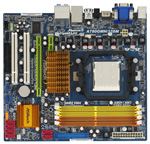 |
The 780G chipset is still going strong and manufacturers are currently updating to second-generation designs based on this IGP workhorse. One of the best second-generation 780G boards in this price category is the ASRock A780GMH/128M. ASRock has done a masterful job in updating their previous GM-LE series of boards. From the new packaging design and accessory kit components to the revised layout, we would be hard pressed to find a better value in this price range. The A780GMH/128M utilizes the AMD/ATI Radeon 3200 integrated graphics engine along with 128MB of Side Port memory to deliver excellent integrated performance. This board features the revised SB710 Southbridge that features six 3Gb/s SATA ports with RAID 0/1/10 support, 7.1 HD audio from the VIA VT1708S codec, 10 USB 2.0 ports, and Gigabit LAN with the revised Realtek RTL8111DL controller. The board has a single PCI-E x16 slot, one PCI-E x1 slot, and two PCI slots along with support for 16GB of memory. ASRock now includes three video output options with D-Sub, DVI-D, and HDMI ports all available on the I/O panel.
All current AM2/AM2+/AM3 processors are supported via an overclocking friendly BIOS. The only (minor) drawbacks with the board are the lack of IEEE 1394a capability and fan control options for the system fan headers. The quality of components utilized in the board is excellent at this price point and we have put the board through a grueling 30-day test period without any problems to date. This board is worthy of an award and we will have a complete review on it shortly, but in the meantime it carries our highest recommendation in this price category.
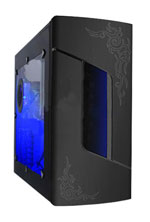 |
There always seems to be some version of the Sigma mid tower with the Sigma 500W PSU on sale or rebate. The case and power supply choice for this guide is the Sigma La Vie Leather Black. This case and power supply are currently on sale for $45 after a $20 rebate. Sigma makes both decent cases and decent power supplies sold individually. While no one will mistake this case/PSU combo for one of the premium Sigma offerings, it is still good quality and good value for a very reasonable price. Even if you pay the regular price of $60 to $65 you will get good value in this combo. We have built several entry systems with the Sigma case and PSU and had good results and stable performance. The only caveat is to check out the case when it arrives as shipping can take its toll on the case front door.
If you prefer a smaller case to mate with a Micro ATX motherboard, the HEC 6K28BSOH48D mini tower with a 485W power supply is an option. It is a solid small case with a power supply form HEC, which is one of the world's best PSU makers. You should generally go for the best case and power supply you can reasonably afford, so you should also look at the cases and power supplies recommended for more expensive systems - particularly if you plan to keep your case/PSU and merely upgrade other components in the future.
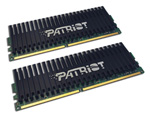 |
With DDR2 prices so very low, we went for 4GB of DDR2-800. This is double last year's entry recommendation for less than half the price. RAM prices as a whole are certainly in the commodity category. There have been small increases in memory prices the last few weeks so you may need to shop a little more for the best price. We recommend the Patriot Viper 4GB DDR2-800 CAS 4 kit, which is just $27 after mail-in rebate. This is faster than our last guide recommendation of CAS5 memory at DDR2-800. You could just as easily choose OCZ, Kingston, Corsair, Crucial, GeIL, Patriot, A-Data or any other quality brand and shop for memory based on a combination of price, timings, and the company's support reputation. Again, if you are truly pinching pennies you can save about $8 by going with 2x1GB DDR2-800 instead at $19 to $20.
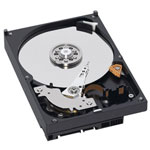 |
Hard drive capacity continues to grow, and we again selected the tried and true Western Digital Caviar 500GB for our entry system. It seems a waste to choose a lower HD capacity when 500GB is now available for under $60. While there are differences between hard drives, outside of running benchmarks most people aren't likely to notice the difference in performance between Western Digital, Seagate, Samsung, Hitachi, and other major brands. All are worthy of consideration if the price per gigabyte (or terabyte) is right.
 |
For the optical drive we went for the newest and fastest Sony 24X DVDRW. With the market moving toward Blu-ray players and 25GB/50GB Blu-ray burners, DVD writers have continued to drop in price. However, a BR player or burner is still a bit rich for an entry system. A Sony DVD writer that supports dual-layer and 24X DVD writes for $24 is a bargain indeed.
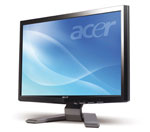 |
The last major component to discuss is the display, and here the tilt must be toward price in an entry system. $100 is a low price for an LCD monitor, but with the prices of LCD monitors dropping $110 now buys a 19" widescreen Acer monitor with a 1680x1050 native resolution. That's a decided step up from the $99 17" LCD chosen in the last Entry System Guide, and the Hanns-G was a 17" 1440x900 LCD. This Acer has the same resolution as most 22" widescreen monitors. You will not give up resolution with this monitor, but things will be a bit smaller.
If your budget allows, you can choose the 21.5" ASUS VH222H with true HD 1920x1080 resolution at $160 after a $10 rebate. 21.5"/22" True HD is today's sweet spot, since the next step up to 23.6"/24" starts around $250. If your budget can stretch to $160, that is money well spent on a 21.5" 16:9 HD wide screen display. We'll have a bit more to say about LCDs on page 4, if you're interested in discussing quality.










65 Comments
View All Comments
bupkus - Tuesday, May 19, 2009 - link
Could you list a Crossfire motherboard option for those who think of a budget system as one that would allow a second HD4770 for future upgrade?Gary Key - Wednesday, May 20, 2009 - link
Hi,Unlike the AMD side, there are not any standout CF boards that fit within our budget guidelines for this article. That said, I like the DFI BI P45-T2RS at $107, ASRock P45XE at $90, Biostar TForce TP45HP at $100, and my favorite P45 board, the Gigabyte GA-EP45-UD3P at $130 but $110 with a rebate right now.
With the last BIOS update, the DFI LP JR P45-T2RS at $110 is an interesting choice as it is an uATX format and works well in a SFF system, especially with two HD4770 cards. I have not tested the ECS BS P45T-A, but it seems to have positive comments around the forums (looking at price compared to performance/quality) for $82 with the MIR.
Wesley Fink - Tuesday, May 19, 2009 - link
For an AMD CPU there are lots of good Crossfire X motherboard choices. One geed choice is the Asus M4A78 Plus which sells for just $79 so it still fits the budget very well.Choosing an Intel board with dual PCIe x16 slots is a lot more difficult. I have asked Gary Key, our Motherboard Editor, to comment on an Intel choice.
PC Reviewer - Monday, May 18, 2009 - link
id change the video card to an hd 4890 if you could throw in the extra money..http://pcreviewer.org/new-radeon-hd-4890-video-car...">http://pcreviewer.org/new-radeon-hd-4890-video-car...
Lunyone - Monday, May 18, 2009 - link
As the previous poster stated that the Gigabyte g41 mobo listed has only 2 DIMM slots and not 4 as pictured in the article. This is one of the main reasons I prefer AMD mobo's over most Intel based mobo's. AMD's mobo's "usually" have more options included for a given price (usually less than Intel based ones). This isn't always true, but I'd say that 80-90% of the time it is true.Anyone know of any good links to the Sigma 500w PSU?? I'm just curious how well it does under testing or in real world situations. I try and keep up on good PSU's and I'm having a hard time finding reviews for the Sigma PSU listed in this review. I've read some on their other offerings >650w, but can't seem to find one for the 500w level.
Wesley Fink - Tuesday, May 19, 2009 - link
We had the correct Gigabyte G41 photo in the images, but the wrong link. THat has been corrected and you will now see the small image with the two dimm slots, which is all available on the $65 G41 MB.The 2 dimm slots can easily handle our recommended 4GB of memory. If you want more than 4GB you will need a more expensive motherboard.
Shocker1322 - Sunday, May 17, 2009 - link
I happen to be specing out a computer that is also using the GA-G41M-ES2L, however the picture posted looks to be that of a GA-EP45-UD3R. A key difference is the 4 DIMM slots on the GA-EP45-UD3R vs the 2 DIMM slots on the GA-G41M-ES2L.PrinceGaz - Friday, May 15, 2009 - link
I know the main point of this article was main system recommendations, but I would suggest you do some basic research before recommending some of the other bits to go with it.The recommendation of the Logitech EX110 wireless keyboard and mouse set literally left me open-mouthed. Just because it has the Logitech name doesn't mean it is a quality product. I had an EX110 for a day. The keyboard was DOA, and the mouse both felt and acted like the very cheap optical mouse it was (when left stationery, the mouse pointer slowly creeped to one side, and sometimes the mouse pointer jumped to the edge of the screen). And that's before the batteries. The EX110 is known to eat batteries very quickly, so you should add the cost of some NiMH rechargeables (and the charger if necessary) to the system build cost. My overall impression of it (the keyboard didn't work but I still got a feel for how the keyboard felt) was that it was bargain-bin no-name product, which Logitech have foolishly stuck their name on to capture some of the low-end market.
Spend a touch more on the keyboard and mouse and you can get products which perform much better, like the LX-6 mouse which can run off a single AA cell for two or three months of heavy use (or you can put two in for double the life as they are connected in parallel), instead of using two of them in a week or so. As for the keyboard, any RF wireless keyboard with sufficient range should be fine as even the cheap ones don't eat batteries (there is no potentially power-draining LED or laser needed on a keyboard), and an HTPC is unlikely to be used for serious typing duties.
Apart from that small point about what I guess was a blind "this is cheap and is wireless from a good company" recommendation of the EX-110, it was an excellent article.
Ah yeah, one other thing made me smile: on the page 3 (Intel entry-level) about the Asus P5QL-CM mobo:
"It is not an overclocking demon with our E5200/E7200 being limited to the 345FSB range due to the chipset, but that is more than enough headroom (4.16GHz with the E5200) for most users."
This is the entry level system costed at around US$300 for the base system, and you feel the need to mention the recommended CPU with that mobo will probably not be able to be overclocked beyond 4.16GHz from its stock 2.5GHz! Good grief, if it were an overclocking-system guide, then you might mention that, buy you are talking about what is an over 70% overclock limitation in what is an entry-level box! Seriously-- a 70% overclock limitation because of the mobo in an entry-level box.
strikeback03 - Monday, May 18, 2009 - link
We have bought 3 of the EX110 sets for student computers here at work. All have worked on arrival, and none eat batteries excessively (couple months per charge). The keyboard isn't the highest quality, but my biggest concern for HTPC use would be the range. They seem to be limited to a few feet, which would mean the receiver would have to be buried in the couch or something.pirspilane - Wednesday, May 27, 2009 - link
Yes, the range is a problem. The EX110 is better suited for desktop use.I put the RF receiver on the top rear of my armoire, since the cord wouldn't reach to the front. Reception was erratic from only 6 feet away.
It works OK now that I moved the receiver to the front of the armoire on top of the TV shelf.